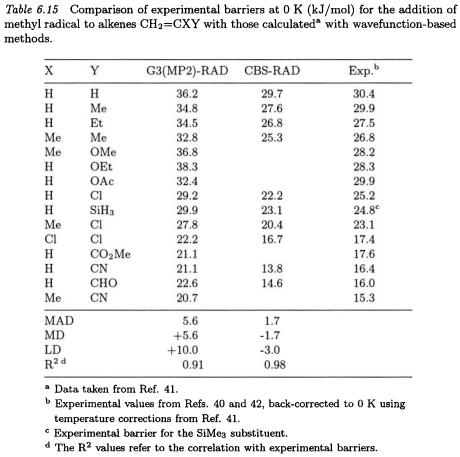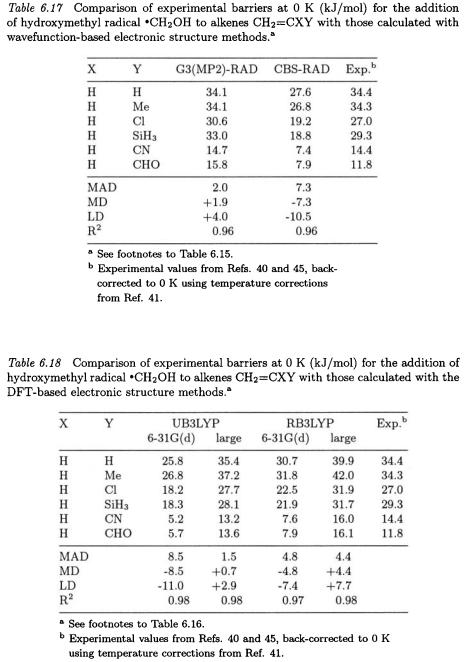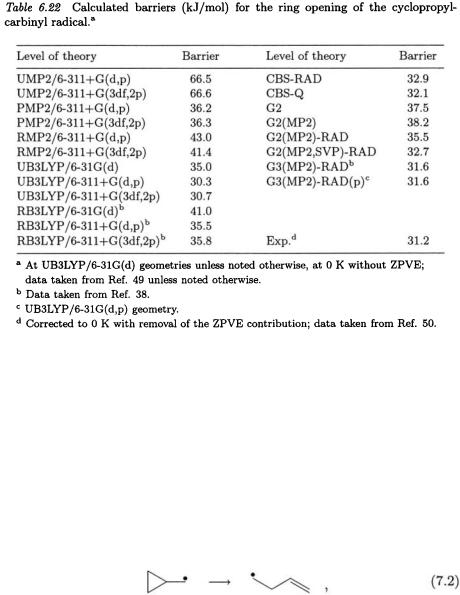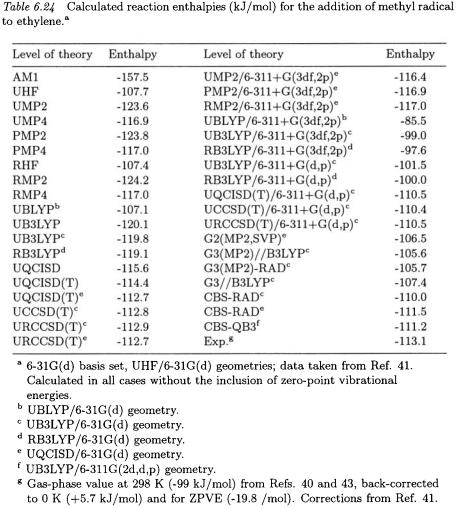
- •Table of Contents
- •Preface
- •Contributors
- •1. INTRODUCTION
- •2. HIERARCHIES OF AB INITIO THEORY
- •2.3. Computational Cost
- •3.2. The CCSD(T) Model
- •4.1. Electronic and Nuclear Contributions
- •4.2. Dependence on the AO Basis Set
- •5.2. Extrapolations from Principal Expansions
- •6. CALIBRATION OF THE EXTRAPOLATION TECHNIQUE
- •6.2. Total Electronic Energy
- •6.3. Core Contributions to AEs
- •7. MOLECULAR VIBRATIONAL CORRECTIONS
- •8. RELATIVISTIC CONTRIBUTIONS
- •9. CALCULATION OF ATOMIZATION ENERGIES
- •10. CONCLUSIONS AND PERSPECTIVES
- •2. STEPS IN THE W1 AND W2 THEORIES, AND THEIR JUSTIFICATION
- •2.1. Reference Geometry
- •2.2. The SCF Component of TAE
- •2.3. The CCSD Valence Correlation Component of TAE
- •2.4. Connected Triple Excitations: the (T) Valence Correlation Component of TAE
- •2.6. Scalar Relativistic Correction
- •3. PERFORMANCE OF W1 AND W2 THEORIES
- •3.2. Electron Affinities (the G2/97 Set)
- •3.4. Heats of Formation (the G2/97 Set)
- •3.5. Proton Affinities
- •4. VARIANTS AND SIMPLIFICATIONS
- •4.2. W1h and W2h Theories
- •4.5. W1c Theory
- •4.6. Detecting Problems
- •5. EXAMPLE APPLICATIONS
- •5.1. Heats of Vaporization of Boron and Silicon
- •5.2. Validating DFT Methods for Transition States: the Walden Inversion
- •5.3. Benzene as a ”Stress Test” of the Method
- •6. CONCLUSIONS AND PROSPECTS
- •1. INTRODUCTION
- •2. THE G3/99 TEST SET
- •4. G3S THEORY
- •5. G3X THEORY
- •6. DENSITY FUNCTIONAL THEORY
- •7. CONCLUDING REMARKS
- •1. INTRODUCTION
- •2. PAIR NATURAL ORBITAL EXTRAPOLATIONS
- •3. CURRENT CBS MODELS
- •4. TRANSITION STATES
- •5. EXPLICIT FUNCTIONS OF THE INTERELECTRON DISTANCE
- •7. NEW DEVELOPMENTS
- •7.1. The SCF Limit
- •7.2. The CBS Limit for the MP2 Correlation Energy
- •7.4. Total Energies
- •8. ENZYME KINETICS AND MECHANISM
- •9. SUMMARY
- •1. INTRODUCTION
- •2. ELECTRON PROPAGATOR CONCEPTS
- •3. AN ECONOMICAL APPROXIMATION: P3
- •4. OTHER DIAGONAL APPROXIMATIONS
- •5. NONDIAGONAL APPROXIMATIONS
- •7. P3 TEST RESULTS
- •7.1. Atomic Ionization Energies
- •7.2. Molecular Species
- •8. CONCLUSIONS AND PROSPECTUS
- •1. INTRODUCTION
- •2. THEORETICAL PROCEDURES
- •3. GEOMETRIES
- •4. HEATS OF FORMATION
- •5. BOND DISSOCIATION ENERGIES
- •6. RADICAL STABILIZATION ENERGIES
- •7. REACTION BARRIERS
- •8. REACTION ENTHALPIES
- •9. CONCLUDING REMARKS
- •1. INTRODUCTION
- •2. HOMOLEPTIC CARBONYL COMPLEXES
- •4. IRON CARBONYL COMPLEXES
- •5. GROUP-10 CARBONYL COMPLEXES
- •7. NOBLE GAS COMPLEXES
- •8. TRANSITION METAL CARBENE AND CARBYNE COMPLEXES
- •12. TRANSITION METAL METHYL AND PHENYL COMPOUNDS
- •13. TRANSITION METAL NITRIDO AND PHOSPHIDO COMPLEXES
- •15. MAIN GROUP COMPLEXES OF BeO
- •16. CONCLUSION
- •1. INTRODUCTION
- •2. THEORETICAL BACKGROUND
- •3. SPECIFIC CONVENTIONS
- •4. STATISTICAL EVALUATIONS
- •5. DISCUSSION
- •Index

Theoretical Thermochemistry of Radicals |
181 |
7.REACTION BARRIERS
There has been a number of theoretical studies which demonstrate that the accurate prediction of barriers for radical addition reactions is not straightforward [39, 40].
As an illustration of the performance of various levels of theory in determining such barriers, we examine the addition of radicals to alkenes, beginning with methyl radical addition to ethylene,
Barriers for reaction (7.1), calculated at a wide variety of levels, are presented in Table 6.14. The theoretical results [41] are compared with the experimental barriers obtained from condensed phase (21.3 kJ/mol) [40, 42] and gas-phase (25.7 kJ/mol) [43] studies, back-corrected for temperature and zero-point energy effects [41, 44].
The first point to note is the extremely large variation in calculated barriers with level of theory that range from 7 kJ/mol (AM1) to 90 kJ/mol (RHF). The UMP2 level of theory gives a barrier of 60 kJ/mol. Higher levels of theory [G2(MP2,SVP), G3, G3(MP2), CBS-RAD, CBSQB3, and  ] all give values in the range of 20.5 - 28.6 kJ/mol, which compare favorably with both experimental values. The UB3LYP procedure also performs quite well, giving barriers of 18.3, 25.0, and 25.6
] all give values in the range of 20.5 - 28.6 kJ/mol, which compare favorably with both experimental values. The UB3LYP procedure also performs quite well, giving barriers of 18.3, 25.0, and 25.6
kJ/mol |
with the 6-31G(d), 6-311+G(d,p), and 6-311+G(3df,2p) ba- |
sis sets, |
respectively. Somewhat higher barriers are obtained at the |
RB3LYP level of theory (23.4, 30.3, and 30.8 kJ/mol, respectively). The results in Table 6.14 indicate that basis set effects are small,
generally less than 7 kJ/mol, but are greater for the DFT-based than for conventional procedures. The barriers tend to increase with basis set size for the B3LYP functional but to decrease with basis set size for the wavefunction-based ab initio methods. The barriers demonstrate much greater sensitivity to the theoretical procedure used.
It is interesting to note that the CBS-RAD and CBS-QB3 levels of theory give barriers (20.5 and 20.7 kJ/mol, respectively) close to the value derived from the condensed-phase experimental measurements, whereas the G2(MP2,SVP), G3(MP2)//B3LYP, G3(MP2)-RAD, G3//B3LYP, and  procedures give results (28.6, 28.3, 27.2, 26.6, and 27.0 kJ/mol, respectively) in accord with the value derived from the gasphase experimental measurements. It is therefore difficult to provide a definitive assessment of their accuracy at the present time. However, despite these differences, it is important to note that all of the higherlevel methods give barriers for the addition of methyl radical to ethylene within approximately a 9 kJ/mol range.
procedures give results (28.6, 28.3, 27.2, 26.6, and 27.0 kJ/mol, respectively) in accord with the value derived from the gasphase experimental measurements. It is therefore difficult to provide a definitive assessment of their accuracy at the present time. However, despite these differences, it is important to note that all of the higherlevel methods give barriers for the addition of methyl radical to ethylene within approximately a 9 kJ/mol range.

182 |
Chapter 6 |
The data compiled in Tables 6.15 and 6.16 indicate how a selection of methods perform in determining reaction barriers for methyl radical additions to a series of substituted alkenes. The experimental values with which comparisons are made in Tables 6.15 - 6.20 come from experiments in solution [40, 42, 45, 46] so there is the possibility of non-negligible solvent effects in some instances.

Theoretical Thermochemistry of Radicals |
183 |
The UB3LYP/6-31G(d), RB3LYP/6-31G(d) and CBS-RAD procedures perform quite well, with mean absolute deviations from experiment of 2.0, 2.8, and 1.7 kJ/mol, respectively. On the other hand, the UB3LYP/6-311+G(3df,2p), RB3LYP/6-311+G(3df,2p), and G3(MP2)- RAD procedures give larger MADs of 5.2, 9.8, and 5.6 kJ/mol, respectively. All levels of theory display an excellent correlation with experiment  The UB3LYP/6-31G(d) and CBS-RAD methods tend to give slightly lower barriers than experiment (MD of -1.6 and -1.7 kJ/mol, respectively) while the remaining levels of theory in Tables 6.15 and 6.16 generally give higher barriers than experiment (MD of +2.7 to +9.8 kJ/mol).
The UB3LYP/6-31G(d) and CBS-RAD methods tend to give slightly lower barriers than experiment (MD of -1.6 and -1.7 kJ/mol, respectively) while the remaining levels of theory in Tables 6.15 and 6.16 generally give higher barriers than experiment (MD of +2.7 to +9.8 kJ/mol).
Investigation of the addition of substituted methyl radicals to substituted alkenes allows for a broader assessment of the performance of

184 |
Chapter 6 |
the various theoretical procedures, particularly in situations for which there may be significant polar effects. Tables 6.17 and 6.18 list barriers for hydroxymethyl radical additions at a selection of levels of theory.
At the UB3LYP/6-31G(d) and CBS-RAD levels of theory, barriers for the limited number of hydroxymethyl radical additions exhibit larger MADs from experiment (8.5 and 7.3 kJ/mol) than those observed for the methyl radical additions (Tables 6.15 and 6.16). In contrast, barriers obtained at the UB3LYP/6-311+G(3df,2p) and G3(MP2)-RAD levels

Theoretical Thermochemistry of Radicals |
185 |

186 |
Chapter 6 |
of theory display good performance, with MADs of 1.5 and 2.0 kJ/mol, respectively. Once again, the UB3LYP/6-31G(d) and CBS-RAD procedures give barriers lower than experiment, while at the G3(MP2)-RAD level barriers are generally higher. Interestingly, the RB3LYP/6-31G(d) method underestimates the barriers for these hydroxymethyl radical additions to a similar extent its RB3LYP/6-311+G(3df,2p) counterpart overestimates them. All levels of theory display a very good correlation with experiment, with  ranging from 0.96 to 0.98.
ranging from 0.96 to 0.98.
Calculated barriers for a selection of cyanomethyl radical additions are presented in Tables 6.19 and 6.20. The CBS-RAD method performs particularly well (MAD of 1.3 kJ/mol) for the selected cyanomethyl radical additions. However, the other levels of theory show somewhat larger mean absolute deviations (5.9 - 14.8 kJ/mol). With the exception of CBS-RAD (MD of -0.9 kJ/mol), all levels give higher barriers than those observed experimentally (MD of +5.9 to +14.8 kJ/mol). The correlation with experiment  is somewhat poorer than that for the methyl and hydroxymethyl radical additions (Tables 6.15 - 6.18).
is somewhat poorer than that for the methyl and hydroxymethyl radical additions (Tables 6.15 - 6.18).
The overall performance of each of the six levels used to estimate the barriers for radical additions to substituted alkenes (Tables 6.15 - 6.20) is summarized in Table 6.21. The CBS-RAD procedure gives the best overall performance (MAD of 3.2 kJ/mol) and generally underestimates

Theoretical Thermochemistry of Radicals |
187 |
the radical addition barriers (MD of -2.9 kJ/mol). The G3(MP2)-RAD method performs less well than its CBS-RAD counterpart (MAD of 5.4 kJ/mol) and tends to overestimate the barriers (MD of +5.3 kJ/mol). The UB3LYP/6-31G(d) and RB3LYP/6-31G(d) results demonstrate the same mean absolute deviation from experiment (4.3 kJ/mol) but whereas the UB3LYP procedure used in conjunction with the small basis set tends to underestimate the radical addition barriers (MD of -1.5 kJ/mol),

188 |
Chapter 6 |
the RB3LYP procedure overestimates them (MD of +2.1 kJ/mol). A basis-set effect of ca. 7.5 kJ/mol is observed for both the UB3LYP and RB3LYP procedures.
The results presented in Table 6.21 show that the good correlation between calculated and experimental barriers observed for the addition of the individual radicals (Tables 6.15 - 6.20) deteriorates significantly when the radicals are examined together. Further work is in progress to try to understand this variation in performance. The largest deviations from experiment are rather larger than desirable (LD ranging from -11.0 to +16.6 kJ/mol).
The ring opening of the cyclopropylcarbinyl radical,
has been described as ”the most precisely calibrated radical reaction” [47] which makes it ideal for evaluating the performance of theoretical methods. This is one of the fastest unimolecular reactions known [48].
The barriers for this reaction calculated for a range of higher-level procedures (Table 6.22) [49] show that the CBS methods agree well with experiment while their G2 counterparts generally overestimate the

Theoretical Thermochemistry of Radicals |
189 |
barrier. The better performance of the CBS methods over the standard G2 approaches has been attributed [49] to the spin-contamination correction that in this instance lowers the barrier by approximately 5 kJ/mol. Of the non-standard methods, the G2(MP2)-RAD procedure offers a slight improvement over its standard G2(MP2) counterpart, while the G2(MP2,SVP)-RAD, G3(MP2)-RAD and G3(MP2)-RAD(p) approaches give results close to the experimental barrier.
The UB3LYP barriers calculated with larger basis sets, namely 6-311+G(d,p) and 6-311+G(3df,2p), are in close agreement with experiment. The RB3LYP barriers are ca. 5.0 kJ/mol higher than their UB3LYP counterparts. The UMP2 approximation performs poorly in estimating the barrier to ring opening. This may be attributed to the significant spin contamination  observed in the transition structure for this process. The PMP2 and RMP2 methods, while still over-estimating the barrier, offer a significant improvement over UMP2.
observed in the transition structure for this process. The PMP2 and RMP2 methods, while still over-estimating the barrier, offer a significant improvement over UMP2.
Table 6.23 presents calculated barriers for the cyclization of the but-3-enyl radical [i.e. the reverse of reaction (7.2)]. This reaction is an example of an intramolecular radical addition. A number of the features observed in the barriers for the intermolecular radical additions (e.g. methyl radical addition to ethylene, Table 6.14) are also seen here.

190 |
Chapter 6 |
For example, the UMP2 level of theory performs poorly, the RB3LYP approach predicts higher (by ca. 5 - 6 kJ/mol) barriers than its UB3LYP counterpart, and the G3(MP2)-RAD level of theory gives a higher barrier than the CBS-RAD method. One noticeable difference is the absence of a significant basis-set effect in the DFT calculations on the intramolecular addition.
